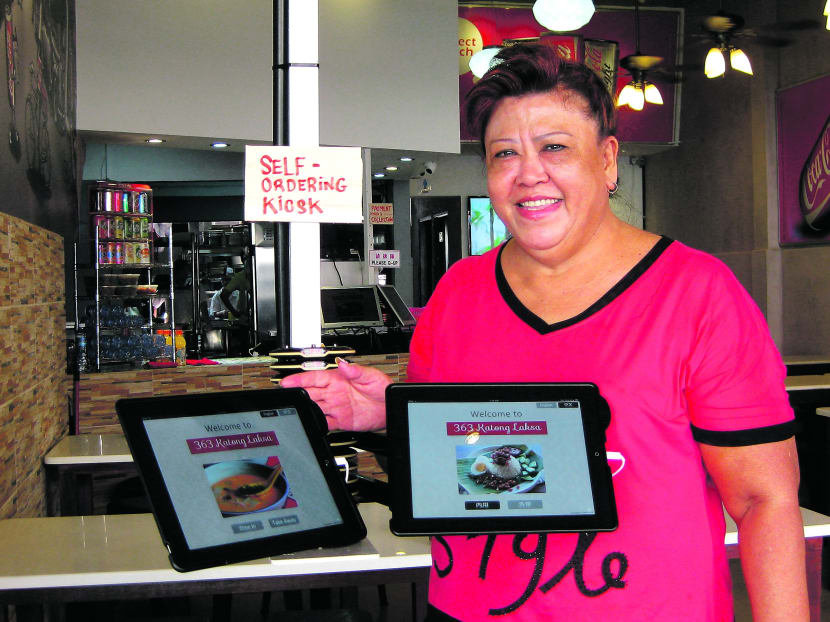Picking up the tab may soon only require a few taps
SINGAPORE — To cope with the labour crunch, restaurants have been embarking on a variety of measures, from automated queue systems to electronic menus.

363 Katong Laksa Co-Owner Tan Ah Hiok, 60. Her Holland Village coffee shop has deployed a variety of e-solutions, from an electronic self-service kiosk (picture) to computerised ovens and fridges. PHOTO: TABSQUARE
SINGAPORE — To cope with the labour crunch, restaurants have been embarking on a variety of measures, from automated queue systems to electronic menus.
Now, the next phase of the dining experience appears to be automated payments, so that customers can do it themselves and no longer need to wait for that final step.
In recent months, restaurants, banks and system providers have been in discussions to work out how to do that — which platform is best, as well as identifying and addressing security risks, among other issues.
TabSquare, an electronic menu system provider, will be the first to launch a dongle-based mobile payment system: The dongle attached to an iPad tablet menu will read the customer’s credit card chip.
The system is being launched at one restaurant as a start, with five more in the works, said TabSquare partner Anshul Gupta.
Another provider, Aptsys, is now in discussions with a local bank and mobile phone manufacturer to develop the mobile payment systems and infrastructure. Such automated payments could take a few forms.
“We could have terminals running on Wi-Fi and using PayPal, but the risk is higher. Another option is that customers could use their mobile phones to make the payment,” managing director Ernest Lim said, adding that the latter is more likely.
ALL THINGS CONSIDERED
But restaurant owners are approaching this cautiously for now, due to perceived higher costs and security risks.
The Timbre Group of restaurants, which uses iPads as ordering systems at its outlets, is interested in automating payments but needs time “to look at reducing risks, and partnering with firms that can provide that level of security”.
“Also, how (do we) sync it with our existing point of sales systems? Customers also need convincing on switching habits,” said managing director Edward Chia.
The cost of upgrading to this system is another concern. Mr Chia spent a “substantial amount” on upgrading Internet speeds and hardware, when he implemented e-ordering at his outlets and continues to do so.
Meanwhile, more restaurants and cafes, caught in a bind as they are forced to wean off their addiction to cheap labour, have been taking up electronic ordering solutions.
To date, 85 restaurants have been supported by SPRING Singapore, the Employment and Employability Institute and the Infocomm Development Authority in productivity improvements, excluding grants offered by other agencies, such as the Inland Revenue Authority of Singapore.
Solutions providers are also rapidly increasing sales this year. Aptsys reported doubling of sales every month this year, with 50 chains as clients to date, while TabSquare said 18 new customers have signed up in the past three months, a “significant jump” compared to last year.
SMALLER ACTS EMBRACING TECHNOLOGY, TOO
While Aptsys only serves food and beverage chains, for economies of scale — it costs S$4,000 per outlet, excluding costs of the iPads — even coffee shops and smaller bistros are getting into e-solutions.
Holland Village coffee shop 363 Katong Laksa has deployed a variety of these, from an electronic self-service kiosk to computerised ovens and fridges.
Customers place orders at the kiosk, including special requests such as more cockles or none, take a pager that beeps once orders are ready, collect their food and pay at the counter.
Co-owner Lance Ngo, 33, said this tackles the labour crunch: “My growth was affected, as I had difficulty hiring new people. Even then, it took a long time to train them to cook, about three to six months. Now, using my computerised ovens to cook the food, it takes far less time to train.”
The coffee shop takes in up to 400 table orders daily, and he hopes its rejuvenated image also helps in attracting younger, local staff who do not like working in traditional coffee shops.
He added: “Last time, in trying to handle the massive orders — and moreover, laksa has a lot of variations — our helpers had to ask everyone whether they wanted cockles, more chilli or not. They got pretty sick of the job.”
Furthermore, Grub, a bistro at Bishan Park, said its automated queueing system allows its staff to do more important tasks. Customers can register at its kiosk, indicating how many seats they need. They can wander off while waiting for the automated call when the table is available. Co-owner Amanda Phan said: “(The staff) can now focus on interacting with customers, instead of being pre-occupied with leafing through messy sheets of paper to organise the queue.”






